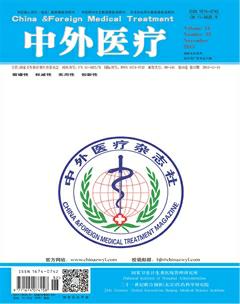连续性肾脏替代疗法对尿毒症脑病患者中分子毒素的清除效果分析
刘国锋 闫红霞

[摘要] 目的 研究连续性肾脏替代疗法对尿毒症脑病患者中分子毒素的清除效果。方法 随机抽取2013年8月—2015年1月该院收治的尿毒症脑病患者62例,按照随机数字表法随机分为对照组(n=30)和观察组(n=32),所有患者均进行基础对症治疗,对照组给予普通血液透析治疗,观察组进行连续性静脉-静脉血液滤过治疗,持续治疗2周后观察对比两组患者治疗效果,并比较中分子毒素清除效果。 结果 观察组有效率93.8%显著高于对照组73.3%,差异有统计学意义(χ2=4.77,P<0.05);两组患者透析治疗后PTH、β2MG、BUN、Scr水平均显著下降,差异有统计学意义(P<0.05);观察组治疗后PTH、β2MG、BUN、Scr水平显著低于对照组,差异有统计学意义(P<0.05)。 结论 采用连续性肾脏替代疗法能有效清除尿毒症脑病患者中分子毒素,临床效果好,值得推广。
[关键词] 连续性肾脏替代疗法;尿毒症脑病;中分子毒素
[中图分类号] R5 [文献标识码] A [文章编号] 1674-0742(2015)11(b)-0001-02
[Abstract] Objective To study the effect of continuous renal replacement therapy on the removal of middle molecular toxins in patients with uremic encephalopathy. Methods 62 patients with uremic encephalopathy admitted into the hospital during August 2013 to January 2015 were selected and randomly divided to the control group (n=30) and the observation group (n=32) according to the random number table method. All the patients received primary symptomatic treatment. The control group were given common hemodialysis therapy while the observation group were treated with continuous veno-venous hemofiltration. The curative effect of the two groups were observed and compared after 2 weeks of continuous treatment and the effect of middle molecular toxin removal was compared. Results In the observation group, the effective rate was 93.8%, which was significantly higher than 73.3% in the control group and the difference was statistically significant(χ2=4.77, P<0.05). There was a significant decrease in PTH, β2MG, BUN and Scr levels of the two groups after dialytic treatment and the difference was statistically significant (P<0.05). After the treatment, PTH, β2MG, BUN and Scr levels of the observation group were significantly lower than those of the control group and the differences were statistically significant(P<0.05). Conclusion Continuous renal replacement therapy can effectively remove the middle molecular toxins in patients with uremic encephalopathy, and the clinical effect is good, which is worth promotion.
[Key words] Continuous renal replacement therapy; Uremic encephalopathy; Middle molecular toxin
尿毒症脑病指尿毒症患者出现神经、精神等中枢神经系统等方面异常,也称为肾性脑病。该病是神经系统最常见的危害,患者早期表现为疲劳、乏力、头痛、头晕、理解力和记忆力减退等,进一步发展会出现烦躁不安、肌肉颤动、幻觉等症状[1-2]。中分子毒素物质会促进尿毒素症性心血管病变的发生,抑制免疫,造成患者营养不良,因此加强中分子毒素的清除,能有效改善尿毒症患者症状及预后[3]。该研究者研究了连续性肾脏替代疗法对该院随机抽取2013年8月—2015年1月收治的62例尿毒症脑病患者的临床应用效果,现报道如下。
1 资料与方法
1.1 一般资料
随机抽取2013年8月—2015年1月该院收治的尿毒症脑病患者62例,其中男37例,女25例,年龄25~64岁,平均(46.7±9.8)岁,病程1~2年;中枢神经系统症状以精神障碍为主者18例,以意识障碍为主者29例,以癫痫、抽搐症状为主者8例;以偏瘫、失语症状为主者7例。所有患者均符合尿毒症脑病诊断标准[4],均伴有不同程度的神经精神异常,且既往无神经精神病史,排除有心、肝、肾脏严重疾病者,排除不签署知情同意书者。将上述56例患者按照随机数字表法随机分为对照组(n=30)和观察组(n=32),观察组男18例,女12例,年龄25~63岁,平均(45.2±9.6)岁,病程1~2年;对照组男19例,女13例,年龄25~64岁,平均(46.2±9.3)岁,病程1~2年,两组患者在年龄、性别、症状的一般资料方面具有可比性,差异无统计学意义(P>0.05)。

